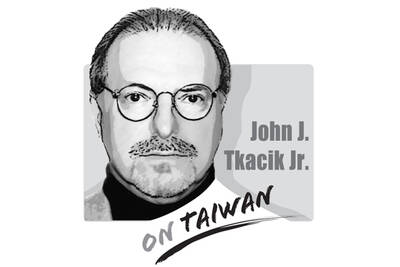The Chinese Communist Party (CCP) has released a plan to economically integrate China’s Fujian Province with Taiwan’s Kinmen County, outlining a cross-strait development project based on six major themes and 21 measures.
This official document by the CCP is directed toward Taiwan’s three outlying island counties: Penghu County, Lienchiang County (Matsu) and Kinmen County. The plan sets out to construct a cohabiting sphere between Kinmen and the nearby Chinese city of Xiamen, as well as between Matsu and Fuzhou. It also aims to bring together Minnanese cultural areas including Taiwan’s Penghu and China’s cities of Quanzhou and Zhangzhou for further integrated development. These three steps show the CCP’s agenda in making Taiwan’s outlying islands in the Taiwan Strait more dependent on China. In doing so, Taiwan’s national defense would be weakened day by day. This is a war strategy designed to subdue one’s enemy without fighting.
Beijing has said that China has made “concessions” in this plan for the sake of Taiwanese. The Chinese government said that Kinmen and Matsu residents would receive the same treatment as residents of Xiamen and Fuzhou. For instance, the plan explained that it would advance the gas, electricity and transportation links between Kinmen and Xiamen, and Kinmen residents would have shared access to Xiamen’s new airport.
Similarly, between Matsu and Fuzhou, water, gas, electricity and transportation links would be established and promoted. The plan said that Taiwanese citizens living in Fujian Province would no longer need to submit temporary residence registration, and would be encouraged to purchase property there. The plan also talked about the “Hakka ancestral land” to bring Taiwanese Hakka and Chinese Hakka together.
Clearly, this plan is attempting to achieve integration through logistics, commerce, education, employment, folk customs, justice, technology, culture and entertainment, to ensure the CCP realizes its goal of so-called “peaceful unification.”
The “concessions” made by Beijing would reinforce China’s grip on Taiwanese living on Penghu, Kinmen and Matsu. Beijing aims to bolster these counties’ dependence on China and have them subjugated, so that they no longer reject and fear China. The purpose is to infiltrate Penghu, Kinmen, and Matsu, and gradually get hold of these three counties’ important resources relevant to people’s livelihoods. If Beijing’s “concessions” and enticements failed to work, Taiwanese residents of these three counties would still be threatened and extorted by the CCP, both physically and psychologically. This is precisely what Russia did to Crimea in 2014.
The CCP released this plan at this moment for a particular reason. Obviously, Beijing aims to turn Taiwan’s front line (which includes Penghu, Kinmen and Matsu) into China’s de facto territory. Through the Taiwanese residents’ minds and lives, China would annex the three counties, and it would be Taiwan’s turn next. Eventually, the nation would become “a part of China.” The plan directed at Penghu, Kinmen and Matsu could be a forerunner of CCP Politburo Standing Committee member Wang Huning’s (王滬寧) new “one country, two systems” project. This should be considered a skirmish before China officially launches its propaganda war against Taiwan.
Taipei should do everything for Penghu, Kinmen, and Matsu residents to build up their immunity against China before it is too late.
Sheng I-che is the host of “Face China.”
Translated by Emma Liu
You wish every Taiwanese spoke English like I do. I was not born an anglophone, yet I am paid to write and speak in English. It is my working language and my primary idiom in private. I am more than bilingual: I think in English; it is my language now. Can you guess how many native English speakers I had as teachers in my entire life? Zero. I only lived in an English-speaking country, Australia, in my 30s, and it was because I was already fluent that I was able to live and pursue a career. English became my main language during adulthood

Somehow, US intelligence identified “the Houthis’ top missile guy” and pinpointed his exact location. At 1348 hours (Washington time), March 15, President Trump’s national security advisor Mike Waltz texted, “positive ID of him walking into his girlfriend’s building.” The unsuspecting Romeo entered. High above, the drone monitoring the building registered a flash. When the smoke cleared, Mr. Waltz texted, “…And it’s now collapsed.” RIP. The star-crossed “top missile guy” had been target number one in the now uproarious US Navy bombing campaign on that Sunday against the Yemeni rebels who have been holding the Red Sea hostage since October 19,
Taiwan on Monday celebrated Freedom of Speech Day. The commemoration is not an international day, and was first established in Tainan by President William Lai (賴清德) in 2012, when he was mayor of that city. The day was elevated to a national holiday in 2016 by then-president Tsai Ing-wen (蔡英文). Lai chose April 7, because it marks the anniversary of the death of democracy advocate Deng Nan-jung (鄭南榕), who started Freedom Era Weekly to promote freedom of expression. Thirty-six years ago, a warrant for Deng’s arrest had been issued after he refused to appear in court to answer charges of
The Opinion page has published several articles and editorials over the past few weeks addressing Taiwan’s efforts to leverage unique or strong aspects of its culture to increase international awareness of the nation. These have included submissions by foreign journalists and overseas students, highlighting how bubble milk tea, Guinness World Record attempts, the entertainment sectors, impressive scenery, world-class cuisine and important contributions to the high-tech supply chain can enhance Taiwan’s recognition overseas and therefore its soft power. That entails competing for attention in already crowded sectors. Other nations, after all, offer popular entertainment exports, beautiful scenic spots and great food.